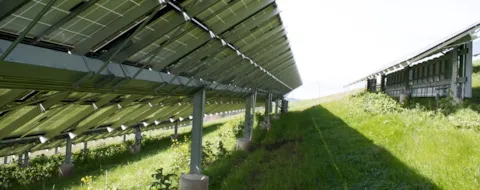Taking ownership of your new solar project: is that in-service date realistic?
DNV is experienced in reviewing geotechnical reports for subsurface risks, as well as reviewing or recommending technical specifications for pile load test programs.
Continuing our series on build-transfer agreements, today we’ll be looking at some of the construction-related risks and opportunities for owners taking possession of their solar plants at or following commercial operation date (COD). It’s common that the seller of an under-construction asset may present an idealized in-service date. What are a couple of key issues that influence construction schedules?
1. Correctly characterizing subsurface risk
It is critical to have an adequate geotechnical investigation defined in the project scope to characterize the subsurface risks which may impact pile driving. Aside from civil works (clearing and grading), the pile driving is next in line on the critical path of the project, because these are the foundations of your PV arrays. Due to the huge quantity of piles (~100,000 piles for 300 MW project) delays in pile driving can have a long lasting impact to the project schedule. A detailed geotechnical investigation including pre-production pile load tests (with sufficient number of borings and pile load tests) can identify any subsurface risks, such as voids, expansive soils or more commonly the presence of hard layers, such as caliche or rock, which cause difficult pile driving and often pile refusals. A thorough investigation allows the engineering, procurement, and construction company (EPC) to anticipate and design alternative methods of pile installation (for example pre-drill pilot holes) to accommodate these difficult driving conditions.
DNV is experienced in reviewing these geotechnical reports for these subsurface risks, as well as reviewing or recommending technical specifications for pile load test programs and appropriate installation methods.
2. Ensuring appropriate mitigants to subsurface risks are applied
It is not enough to just identify the subsurface risks and provide alternative pile designs. When you are installing piles, subsurface conditions may differ from the geotechnical investigation and pile load tests. The EPC needs to be nimble and react appropriately these “unforeseen” subsurface risks. For example, a geotechnical report may identify presence of hard caliche layer requiring pre-drilling for your piles. These are more costly both expense and installation time. But, if the investigation did not contain enough borings, it may not have adequately outlined the subsurface risk, leading to hundreds of pile refusals. Like that game Battleship we used to play as kids; think of the battleships as your enemy, the hard layer of rock which will present difficult pile driving. Each geotechnical boring or pile load test is like a guess, and the more guesses you get, the more accurately you pinpoint the enemy, the rock. When difficult conditions are expected, it is a good idea to increase the number of pile tests during construction across suspect areas to refine the need for this additional work, rather than leap into production assuming the alternative design is the right approach. Alternative pile designs (such as pre-drills) require more time, but the alternative of dealing with “surprise” conditions and the resulting pile refusals can be much more costly.
3. Avoiding costly mistakes repeated thousands of times
PV plant construction consists of repeating the same modular work thousands of times. If incorrect installation techniques are not caught in the beginning stages, mistakes can be carried throughout the entire project. One of our key mitigants is to review EPC agreements and early design packages and find areas that can be strengthened to align with industry best practices to ensure a well-built project, including the addition of a "golden row inspection" at the beginning of the project construction. This is a single completed row with work completed to the point that it would be ready for a mechanical completion inspection. This golden row can then be inspected by DNV to make sure industry best practices are carried through the entire project. On the mechanical side, it is important that everyone sign off on proper installation of the tracker components and module installation. If your piles are installed correctly, tracker installation should proceed relatively smoothly, as it is essentially a repeatable kitted installation. But like the piles, it is important to install the racking properly from the get-go and make sure all parties sign off on the install – make the mistakes once, not thousands of times.
Join us next week as we continue our series, evaluating key assumptions in O&M cost models and how they can influence the purchase price of your project.
4/22/2021 3:00:00 PM
